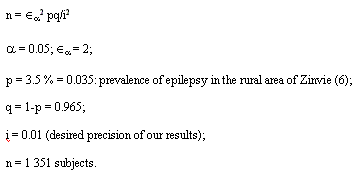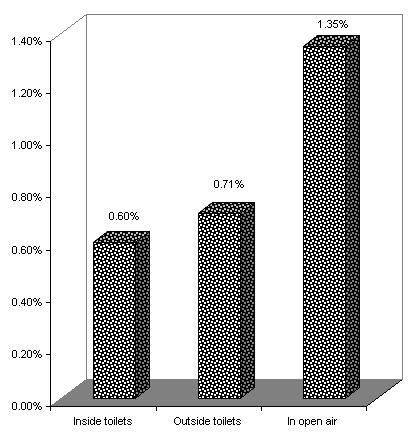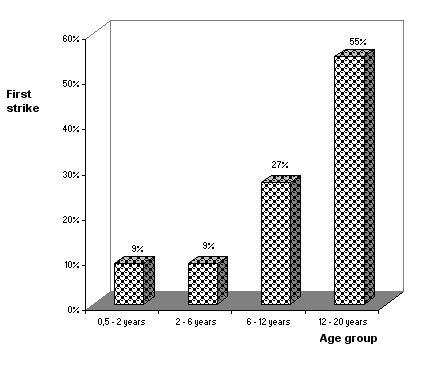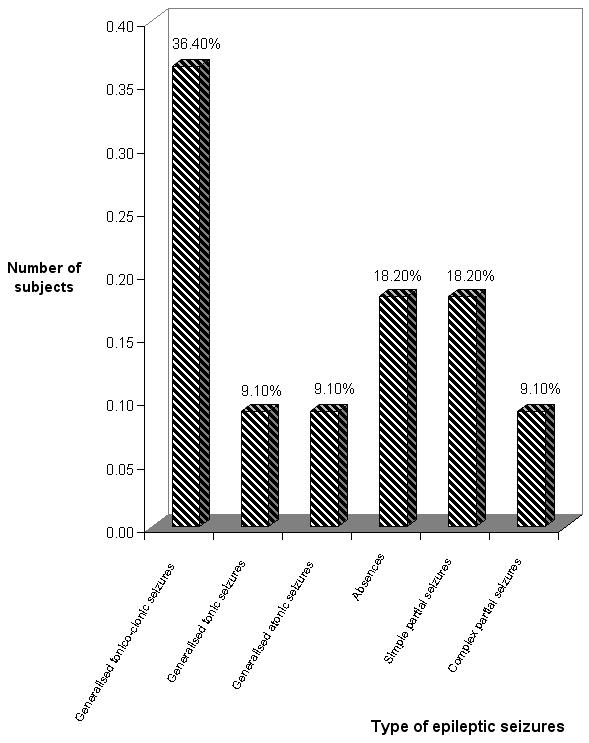CLINICAL STUDIES / ETUDES CLINIQUES
EPILEPSY IN SCHOOLS IN COTONOU (BENIN)
EPILEPSIE EN MILIEU SCOLAIRE A COTONOU (BENIN)
- Unité d’Enseignement et de Recherche de Neurologie de la Faculté des Sciences de la Santé, BP 188 Cotonou, Benin
- Clinique Universitaire de Neurologie du CNHU-HKM, 01 BP386 Cotonou, Benin
ABSTRACT
Background
Despite important progress achieved in the knowledge and case management of epilepsy, this disease still remains burdened by secular beliefs in developing countries. This makes the epileptic, an excluded person with difficulties to access education, training and even appropriate health care.
Objective
The aim of the study is to assess to prevalence of epilepsy in school settings in Cotonou, Benin.
Methods
This cross-sectional study included 1400 subjects, was conducted in the 6th administrative zone of Cotonou and lasted from January 1st to May 31st, 2000.
Results
The prevalence of epilepsy in schools was found to be 7.9‰ (CI95‰ : 4.1‰ – 14.5‰) with a predominance in female subjects (p < 0.02) and an increase with age (p<0.03). There were no significant association between the prevalence and factors such as ethnicity, religion, place of defecation and level of education. Generalised tonico-clonic seizures were the commonest clinical type. From a therapeutic point of view, only 36.4% (4 subjects out of 11) of epileptics benefited from a treatment. Among the latter, 75% had been on indigenous treatment.
Conclusions
These results suggest a relatively high prevalence of epilepsy in school settings in the 6th administrative zone of Cotonou and of a mediocre therapeutic management.
Keywords: Epilepsy, School, Prevalence, Benin, Africa
RESUME
Description
De nombreuses croyances et pesanteurs dans les pays en développement font de l’épileptique un exclu de la société avec de nombreuses difficultés d’intégration sociale, et d’accès à l’éducation, à la formation, aux soins de santé et au travail.
Objectif
L’objectif de cette étude est d’étudier la prévalence de l’épilepsie en milieu scolaire à Cotonou.
Méthodes
Il s’agit d’une étude transversale portant sur 1400 sujets, pendant la période du 1er janvier 2000 au 31 mai 2000, dans la sixième zone administrative de Cotonou.
Résultats
La prévalence de l’épilepsie en milieu scolaire a été estimée à 7,9‰ (IC95‰ : 4,1‰ – 14,5‰) ; avec une prédominance chez les sujets de sexe féminin (p < 0,02) ; et une augmentation en fonction de l'âge (p<0,03). La prévalence ne variait pas significativement avec l'ethnie, la religion, le lieu de défécation et le niveau d'instruction. Les crises généralisées tonico-cloniques ont été les plus fréquentes. Du point de vue thérapeutique, seuls 36,4% (4 sujets sur 11) des épileptiques bénéficiaient d'un traitement. Parmi ces derniers, 75% avaient un traitement traditionnel.
Conclusions
Ces résultats suggèrent une prévalence relativement élevée de l’épilepsie en milieu scolaire dans la sixième zone administrative de Cotonou et une prise en charge thérapeutique médiocre.
Mots clés : Epilepsie, Milieu scolaire, Prévalence, Bénin, Afrique
INTRODUCTION
Epilepsy is one of the commonest neurological diseases in the world. It affects on average 50 millions people worldwide. Its prevalence is 5 to 10 percent higher in developing countries than in developed countries (6,8).
Despite important progress achieved in the epileptology area, this condition is still affected by numerous secular beliefs and cultural practices, making the epileptic, an ostracized person with various problems related to his access to education (20). Education is not only a very sensitive sector of the development of a country since it generates human resources that will model and animate the development system. School and university environments are also the best place for communication and education and should therefore be optimally used in the control of epilepsy. In the framework of communication for behavior change concerning epileptic people, school children and students constitute the interface between communities and teachers, as well as between communities themselves, and could thereby be an excellent vehicle for information, without ethnico-linguistic or socio-economic barriers (2, 20, 21).
The objective of the present study was to analyse epidemiological characteristics of epilepsy in the school and university environment in Cotonou, Benin.
METHODOLOGY
Settings: The study was conducted in the different schools and universities of the 6th administrative zone of Cotonou.
Type of study : It was a cross-sectional study, with a descriptive and analytic purpose. It was carried out from January 1st to May 31st, 2000.
Target population: It is made of children and students attending schools of different levels (primary, secondary and university) in the 6th administrative zone of Cotonou and during the study period.
Sampling:
The sample size has been worked out through the following formulae:

Sampling technique:
Thbe survey was conducted using a three-stage cluster sampling. The basis of sampling was the list of all schools, (primary, secondary and higher education schools) located in the 6th administrative zone of Cotonou. This list was collected from the Regional Office of Education of Atlantique and Littoral Departments and from the Administration of the University of Abomey-Calavi, Benin. At each of the three levels of education, the sampling was done as follows:
– The first stage was a random selection of certain schools of the 6th zone of Cotonou.
– The second stage was the random selection of classes from chosen schools.
– The third stage consisted of randomly selected students from previously selected classes, proportionally to the size of the classes and using a technique of systematic random sampling.
Data collection tools
Data was collected using the standard questionnaire for epilepsy surveys in tropical countries designed through a very collaborative work between the “Institut d’Epidémiologie Neurologique et de Neurologie Tropicale” (IENT) in Limoges, France, the “Pan African Association of Neurological Sciences” (PAANS), and the “International League against Epilepsy” (ILEA) (18).
Case definition:
Inclusion criteria
Was considered as epileptic any person who has experienced over his life course, at least two epileptic seizures. This definition is suggested by the Classification and Terminology Committee of the ILEA, and therefore adopted at international level. A neurologist always confirmed the diagnosis of epilepsy after history taking and clinical examination. All cases of epileptic seizures were retained, whether they were generalised, partial or initially partial and secondarily generalised.
Patients were included whether they were on anti-epileptic treatment or not.
Exclusion criteria
Were excluded from the study, subjects that had had an isolated episode of seizure or episodes occurring during exceptional circumstances such as metabolic disorders or a transient blood flow deficiency, or following a heart related malaise.
Statistic analysis
Statistic analysis of data was performed using the EPI-INFO package, version 6.04 C (CDC Atlanta Georgia).
Frequencies were compared using Pearson X2 test or Fisher exact test as appropriate. The Student test was used to compare means. We used Epitable to calculate 95% confidence intervals.
p< 0.05 was considered as statistically significant.
RESULTS
Presentation of subjects included in the study.
Among 1400 subjects included in the study, 854 were male (61%) and 546 were female (39%). The sex ratio was 1.6.
The age of these subjects varied from 4 to 39 years. The mean age was 16.4 * 7 years for males versus 16.1 * 8.2 years for females. There was no significant difference between these two mean ages (Student t-test).
Almost all of the subjects (99.9 %) lived in urban area. 244 of them (17.4%) were from primary schools; 1092 (78 %) from secondary schools and 64
(4.6 %) from universities.
Prevalence of epilepsy
Out of 1400 surveyed subjects, 11 were confirmed as epileptics, giving a prevalence rate of 7.9 (CI 95 %: 4.5 – 14.5 ). Among 854 male subjects, 3 were confirmed as epileptics, yielding a prevalence rate of 3.5 . Among 546 female subjects, 8 were confirmed as epileptics, giving a prevalence rate of 14.7 . The prevalence rate was significantly higher among female sub-group (p = 0.02). Among 1147 subjects who were less than 20 years old, 6 were identified as epileptics, giving a prevalence rate of 5.3 for this sub-group. Out of 248 subjects who were 20 years old or more, 5 were recognised as epileptics (20.2 ). The prevalence of epilepsy appeared to be significantly higher in subjects aged 20 or more (p= 0.03). Among 244 children from primary schools, 3 cases of epilepsy were identified, leading to a prevalence rate of 12.3 in this sub-group. In the sub-group of 1,156 subjects from secondary schools and higher education, 8 were confirmed epileptics, yielding a prevalence rate of 6.9 (p= 0.2).
The figure N°1 summarises the prevalence of epilepsy in relation to the place where people defecate. The prevalence of epilepsy appeared to be higher among people defecating in the nature (out of toilets) but the difference was not statistically significant (p = 0.5).
Characteristics of epileptic subjects.
Out of the 11 subjects identified as epileptics, 3 were male (27.3%) and 8 were female (62.7%). Their mean age was 18.8 ± 5.4 years. Almost all of them (90.9%) had presented at least a seizure over the last 5 years. The mean age of the first seizure was less than 20 years in all cases. The figure N°2 shows the distribution of epileptics in relation to the age of the first seizure.
In 6 epileptics, no triggering factor was identified. Five patients stated triggerring factors such as: tiredness, 3 cases; lack of sleeping and emotion, 1 case and treatment abandon or dropping down, 1 case. History of consanguinity have been recorded in 1 patient, history of epilepsy in relatives reported by 1 subject and obstetrical trauma were reported in 9 cases.
The figure N°3 summarises different types of epileptic seizure encountered in patients identified as epileptics in the present study. Generalised tonico-clonic seizure was the most frequent (36.4%), followed by partial seizure (18.1%).
Regarding the therapeutic aspect, 7 patients (63.6%) were not ongoing any treatment during the study period. Among the 4 patients (36.4%) who were on a treatment, 2 were having an indigenous treatment, 1 was on a modern treatment while the fourth was on both.
DISCUSSION
Overall prevalence of epilepsy
The overall prevalence of epilepsy in the present study was estimated at 7.9 . This prevalence is largely higher than those reported by Younis et al. (0.9 ) in Sudan (22); Ross et al. (3.7) in England (20); Pazzaglia et al (3 ) and Cavazutti et al (4.5 ) both in Italy (3, 17). The low prevalence found by Younis in Sudan (22) could be due to the fact that data was collected from medical records and from schools Headmasters. Also, the author did not include in his study, cases with generalised tonico-clonic seizure. The prevalence of the epilepsy is therefore probably underestimated in this study, making inappropriate any comparison with our figures. The lower prevalence rates reported by Italian authors (3, 17) could be explained as follows:
– Either the survey was carried out in hospital settings and not in the general population as in our study;
– Or the existence of some etiologic factors specific to tropical areas might explain the relatively high prevalence observed in our study.
Some studies conducted in Africa, reported prevalence rates higher than that found in our study (3, 5, 7). The one carried out by Danesi in Nigeria (5) used two questionnaires of which one was designed for the screening and the other for the confirmation. But the confirmation of the epilepsy was done by medical students, hence the possibility of an overestimation of the prevalence of the disease.
Diop et al’s study in Senegal (7) was limited to children aged between 5 and 9 years. About 33 % of epilepsy cases identified in this study, were related to obstetrical trauma and infectious diseases. Our sample included people whose age varied from 4 to 39 years and yet, we did not observe any case of epilepsy in subjects of less than 10 years.
This prevalence rate of 7.9 that we found in school settings is notably lower than those reported by previous prevalence surveys conducted in general population in Benin (1, 6,13). In a review on epilepsy in Togo, Grunitzky et al. reported such prevalences as 16 and 12.3 . But all the cited studies were conducted on the general population (10). However, other studies carried out on general population in Africa and elsewhere, reported prevalence rates in the same range as the ones found in the present study (15, 17).
Prevalence in relation to gender:
Our study revealed a female predominance for epilepsy in school settings. Other studies conducted in schools, rather found a male predominance (3, 11, 14, 22). This reflects well the situation in the general population where most studies have noted a male predominance (10, 15, 16). Yet, sex ratio close to 1 and even some slight female predominance have been reported in other studies in general population (8, 9, 15) as we have noted in our study. In the literature, female predominance observed in studies conducted in general population have been explained by male drift from the land. In studies where male predominance was found, it was thought that female cases were under-reported by women at marriage age. Male predominance in hospital-based studies might be due to the fact that males are more incline than females to seek health care (13).
Prevalence and specific indice in relation to age
Most of our patients had had a seizure over the last 5 years. This tends to prove that almost all identified cases were active epilepsy. All the patients experienced their first seizure before the age of 20 years. This is consistent with the literature where it is stated that, in developing countries, the majority of first seizures occur during the first two decades of life. (22). This distribution of epileptics in relation to the age at first attack is comparable to those reported by several authors who had conducted their studies in schools and in general population. (14, 15, 22).
Prevalence in relation to education level.
Our study did not found any association between the prevalence of epilepsy and the education level contrary to Holdsworth et al. (12). In a study conducted in England, they found that a high level of education was associated with an increase in epilepsy prevalence. However their study was limited to an observation of primary and secondary schools and did not reach higher education, as our study did
Triggering factors.
More that half of our patients have reported no factors likely to prompt the occurrence of theirs attacks. For those patients who have reported some, these triggering factors are, by decreasing importance, fatigue, emotion, lack of sleep and discontinuation of anti-epileptic treatment. Triggering factors reported by Grunitzky et al. in Togo (10) were by decreasing importance: treatment discontinuation, alcohol consumption, emotional factor, lack of sleep and excessive fatigue. Such factors as drugs and toxics (alcohol, caffeine at overdose, psychotropic drugs) and hyperventilation have not been found in our study. That could be explained by the fact that the study was conducted in school settings where such behaviours are not common.
Medical history
In our study, commonest events reported in the medical history are prolonged labour with two cases of neonatal hypoxia, premature delivery, familial epilepsy and consanguinity. In a prevalence study in general population in Togo, Grunitzky et al (10), reported at first line, familial epilepsy, followed by consanguinity and the combination of both.
Specific indices in relation to the type of attack.
Our study has revealed a predominance of generalised tonico-clonic crises. The predominance of this type of crisis has been reported in almost all studies carried out on epilepsy prevalence in Africa (8, 9, 10). However, some rare African studies have not found the predominance of this type of crisis (4). The predominance of this type of crisis should have resulted from its easy identification by the population and also their misclassification.
Treatment
About 64 % of epileptics identified in our study, had had no anti-epileptic treatment and 50% of those who had been on treatment used traditional therapy. This practice raises the issue of the perception of epilepsy in Africa. In fact, in this continent, epileptic crises are thought to be the result of occult facts (witchcraft, malediction); this leads the patient to consult the traditional healer rather than the physician. Also, in our study, all epileptics who had been on any treatment, might have somehow and at some time, benefited from an indigenous treatment, at least when crises occur, especially at home, and usually as first aid from a member of the family or the neighbourhood.
CONCLUSION
Results from this preliminary study on epilepsy in schools has enabled us to draw out the following conclusions:
The prevalence of epilepsy in school settings is 7.9 . There is a female predominance as well as an increase of the prevalence with age.
The prevalence of epilepsy, as per this study, is associated, neither to the education level, nor to the place of defecation of subjects.
Almost all (90.9 %) of identified cases were active and all of them experienced their first attacks before the age of 20. The commonest types of seizures encountered are generalised tonico-clonic ones and most reported triggering factors are fatigue and emotion. The management of epileptics is deficient and indigenous treatment is the commonest recourse.

Figure 1: Prevalence of epilepsy in relation to the place where people defecate

Figure 2: Distribution of epileptics in relation to the subject age at the first strike

Figure 3: Distribution of different types of epileptic seizures
REFERENCES
- AVODE DG., BOUTEILLE B., HOUNGBE F. et al. Epilepsy, cysticercosis and Neurocyticersosis in Benin. Eur Neurol 1998;39: 60-1.
- BUFFET-ARINAL Y., RUDIN J., THIEBAUT Y. Aspects multidimensionnels des difficultés scolaires des enfants épileptiques. Epilepsies 1999; 11:193-8
- CAVAZZUTI GB. Epidemiology of different types of epilepsy in school age children of Modena, Italy. Epilepsia 1980; 21: 57-62.
- DANESI MA. Classification of the epilepsies: An investigation of 945 patients in a developing country. Epilepsia 1984; 26: 131-6.
- DANESI MA. Epilepsy and the secondary schools in Nigeria. Tropical and geographical medicine 1994; 46 (suppl 3): 25-7.
- DEBROCK C., PREUX PM., HOUINATO D. et al. Estimation of the prevalence of epilepsy in the Benin region of Zinvié using capture-recapture method. International Journal of Epidemiology 2000; 29: 330-5.
- DIOP AG., AGBOHOUI O.L., NDIAYE M., SENE F., NDIAYE JP. Prévalence de l’épilepsie en milieu scolaire sénégalais. Congrès de la P.A.A.N.S 19-23 mai 1996.
- GERRITS CA. West African epilepsy focus. Lancet 1983; 12: 358.
- GOUDSMIT J., FRANSJE W., VAN DER W. Endemic epilepsy in isolated region of Liberia. Lancet.1983; 5: 528.
- GrUNITZKY KE., DUMAS M., MBELLA EM., BALOGOU AM., HEGBE M., RANIANDRISOA H. Les epilepsies au Togo. Epilepsies 1996; 8 : 189-231.
- HOLDSWORTH L., WHITMORE K. A Study of children with epilepsy attending ordinary schools. Their seizure Patterns, progress and behaviour in school. Developmental medicine and child neurology 1974; 16: 746-58.
- HOLDSWORTH L., WHITMORE K. A Study of children with epilepsy attending ordinary schools: Information and attitudes held by their teachers. Developmental medicine and child neurology 1974; 16: 759-65.
- HOUINATO D., MAKOUTODÉ M., TRAORÉ H., KAYITARE MJ., AVODE DG. Prévalence de l’épilepsie dans les sous préfectures d’Athiémé et de Djakotomey (département du Mono ). Le Bénin Médical 1999 ; 11 : 87-91.
- HYMAN PR. An analysis of epilepsy in the student population at the university of Michigan. College health 1969; 17: 227-30.
- OKITUNDU L., KASHAMA W.K. Les aspects épidémiologiques et cliniques des épilepsies du nourrisson et du jeune enfant. Afri J Neuro Sci 1994 ;13 :20-4.
- PASCUAL-LOPEZ M., PASCUAL-GISPERT J., RODRIGUEZ-RIVERA L. Epilepsy: Epidemiological study in a child population. Bol. Med. Hosp. Infant. Mex 1980; 37 : 811-21.
- PAZZAGLIA P., PAZZAGLIA LF. Record in grade school of pupils with epilepsy: an epidemiological study. Epilepsia 1976; 17 : 361-6.
- PREUX PM., DRUET-CABANAC M., DEBROCK C., TAPIE P., DUMAS M. et le Comité de Recherche sur l’Epilepsie de l’Institut d’Epidémiologie neurologique et de Neurologie Tropicale de Limoges. – Questionnaire d’investigation de l’épilepsie dans les pays tropicaux. Bull. Soc. Pathol. Exot., 2000, 93 : 276-8.
- ROSS EM., EVANS D. Epilepsy in Bristol secondary school children. Epilepsia 1972; 13: 7-12.
- SALOU C. Les approches du problème scolaire du jeune épileptique. Epilepsies 1999; 11 :185-




